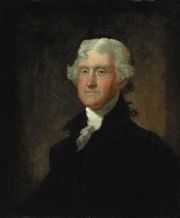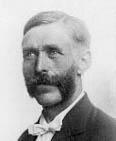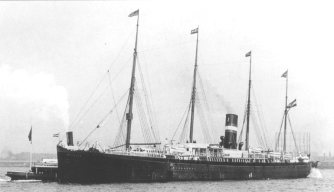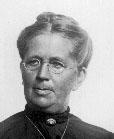Jasia reminded me today that the upcoming Carnival of Genealogy is devoted to the topic of “A Tribute to Women”: “Is there a woman in your family that deserves mention? Do you have a favorite aunt, cousin, or 5th great grandmother that you’d like pay tribute to? Let’s us hear about her!”
My family is graced with a great number of amazing women, but one of the most influential in my life is my maternal grandmother, Doris Thurman Cunningham. When I was very small and learning to talk, she tried to get me to called her Gram or Grams. I couldn’t say it (or perhaps I didn’t want to), and I called her Granna instead. As far as I know, I invented that word. My sister and cousins and all of our children all call my grandmother Granna as well.
I could say a lot about Granna, but I decided that instead of giving her life history, I would write about what she means to me.
Granna and I developed a closeness from the very start. My dad was in Vietnam when I was born, so my mother was staying with her family. Dad came home when I was six months old. I developed gastroenteritis, and it nearly killed me. My mother took me to the emergency room, but she didn’t realize, I don’t think, that she could question the ER personnel when she was told to take me home. My grandmother, wielding her experience with sick children, insisted that I see a doctor. My complexion was gray. The way I hear it told, Granna was memorable. She was so adamant that I see a doctor that years later when she ran into someone in that ER — it may even have been the doctor — he remembered her: “Oh, you’re the grandmother!” At any rate, my life was saved by my grandmother, and not for the last time.
Granna and I became especially close after my family moved to Colorado when my dad left the Air Force. I used to spend the weekend with her as often as I could. Weekends at Granna’s meant staying up late to watch Johnny Carson and The Love Boat and Fantasy Island. She made real air-popped, hot buttered popcorn in a huge bowl and let me use a dish towel to wipe my hands on. It’s funny the little things we think are so special when we were children. To my way of thinking, that dish towel was like a starched linen napkin! She bought a little foam mattress and used to make a pallet for me by her bed, but she didn’t mind if I wanted to climb up next to her and cuddle.
I have a lot of fond holiday memories of times spent at Granna’s house. In 1982, Denver was hit by a Christmas Eve blizzard. We walked to my grandparents’ house in the snow because my sister and I insisted we had to spend Christmas at Granna and Papa’s. We were snowed in for several days, and I just remembered being happy to be with my family.
Granna used to let us create Barbie doll hotels in her dining room. She had these little pieces of carpet, which we lined up so each hotel room had a different carpet. Her folded towels became luxury beds.
When I was eleven, Granna saved my life again by administering the Heimlich maneuver when I was choking. I must have been fairly close to passing out; people talk about how when your life is threatened, you see your life “flash before your eyes.” I did. It was like snapshots filing through my mind really fast.
Granna also took me with her to Germany when I was eleven. She was visiting my uncle, who was stationed in Germany in the Air Force. She had thought he would be coming back to the states, so when I made her promise to take me with her the next time she went, she winked and agreed, thinking she would never have to do any such thing. My uncle’s tour of duty in Germany was extended, however, and Granna found herself packing her bags to visit him again. I reminded her of her promise, and to her credit, she kept it. It would have been very easy to say she didn’t have enough money to buy me a ticket (now that I’m an adult, I know all about such things). But she didn’t do that. She said I could go, so she kept her word.
When I was selected for the National Junior Honor Society in middle school, Granna hung my certificate in her dining room. It’s still there more than thirty years later. When I made her a shelf out of mismatched and badly cut pieces of wood I found in Dad’s garage, finally gluing the sorry lot together with wood glue because I couldn’t get the nails in the wood — let me tell you, that shelf was a sight to behold — Granna proudly displayed the shelf right out where everyone could see it and even put some of her precious figurines on it.
Granna used to pay me a little bit of pocket money if I dusted the shelves in her bathrooms or wiped down her baseboards. She taught me to sew and let me me use her sewing machines (she had a career as a seamstress). She took me out to breakfast and let me drink Cokes — for breakfast! Can you imagine?
When Granna was sewing, she used to hum tunes. I always asked her what she was singing, and she said nothing really. I always wondered where she got all those tunes. I had never heard them before, and they sounded like the prettiest hymns.
in 1992, Granna was diagnosed with breast cancer, and we were all scared. She had a mastectomy and has been cancer free ever since. Later, she lost her sister to breast cancer. She was determined to get well, my mother told me, so that she could come to my wedding.
I have always been able to count on Granna. Her love has been unconditional. I can’t imagine my life without her; without her, I wouldn’t be here at all. She’s a very special person, and I don’t think we tell her that enough.
I love you, Granna.
Technorati Tags: family history, genealogy, tribute



 In my
In my 
 Aaljte Zwier (left) was born in
Aaljte Zwier (left) was born in 




